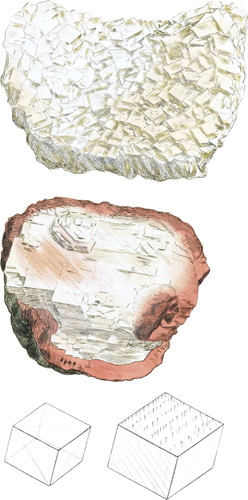 Enlarge
Enlarge
British Mineralogy
Carbonate of Lime
- Div. 1. Crystallized, var. primitive.
The primitive Crystal of Carbonate of Lime formerly being rare in Britain, I was glad to figure even a doubtful specimen upon Coal, in tab. 3. I have lately received from Sherborne, by favour of the late Mr. Herbert a handsome fragment of the lining of an Ammonite, formed of primitive rhombs, which are peculiar for the diagonal striæ upon their surfaces; striæ that seldom appear except upon fractured faces; the upper figure in this plate represents this specimen.
Some years since I had Carbonate of Lime sent me, which, besides the usual rhomboidal fracture (see tab. 2.) had indications of fractures extending across the longest diagonal of the rhombs: as I received it from an Aberdeen dealer, accidentally with other subjects, I was led to consider it a character of Scotch Carbonate of Lime: I paid more attention to it, and found that Carbonate of Lime, when it accompanies Zeolite, has this character strongly. I have since received some from near Keswick, along with Quartz Crystals, and a mass of opaque suetlike Carbonate of Lime, with similar marks, from Lord Dudley’s quarry at Dudley. I have some also by favour of my kind friend Mr. Dauby, from St. Vincent’s Rocks.
A store of curiosities brought from Iceland by the Rt. Hon. Sir Joseph Banks, when he went in the year 1772, to visit the Geysers, or Boiling Fountains, having been rummaged, a quantity of Carbonate of Lime was discovered, with these diagonal striæ sufficiently conspicuous to characterize it; and by some it was soon considered as particularly related lo the volcanic formations: some of the specimens had foliated Zeolite or Stilbite about them (see tab. 259 and 260, where also the diagonal fracture of the Carbonate of Lime is mentioned in the description, vol. iii p. 117: the specimen was from Hall-hill, Kincardineshire.) Sir Joseph, understanding my desire to enquire into the nature of the Carbonate of Lime brought from a determinedly volcanic country, readily welcomed me to take a quantity sufficient for any examination; and all the specimens were marked, and even frequently fractured in conformity to the Ions; diagonal which interrupted their transparency, so that it was Supposed all the specimens were opaque; however, I broke out some very clear fragments; many were really opaque throughout, and all were destitute of the diagonal, mere or less, internally. Thus it appears to be a sort of weathering or external change that renders these lines conspicuous. Some of the specimens from St. Vincent’s Rocks are deeply furrowed with the diagonals, but are destitute of them internally.
If the rhomb be divided by these six long diagonal striæ, it will be resolved into two kinds of molecules, that is six irregular tetrahedrons and two bi pyramidal hexahedrons; but if in the short diagonals there will result six equal irregular tetrahedrons only. Whether this fracture may assist in developing a difference, (besides Dr. Wollaston’s measure of the nucleus) between the Carbonate of Lime, Carbonate of Iron, or Brown-spar and Magnesian Carbonate of Lime, or Bitter-spar, may be a question; I do not know that these latter ever show a diagonal.
It is remarkable that in the Iceland specimens the diagonal flaws are only to be discovered in two directions, and where they cross each other they produce opaque tines, resembling spicule arranged in rows across the rhombs; I have not met with any thing similar in British, specimens; see the right hand outline.

